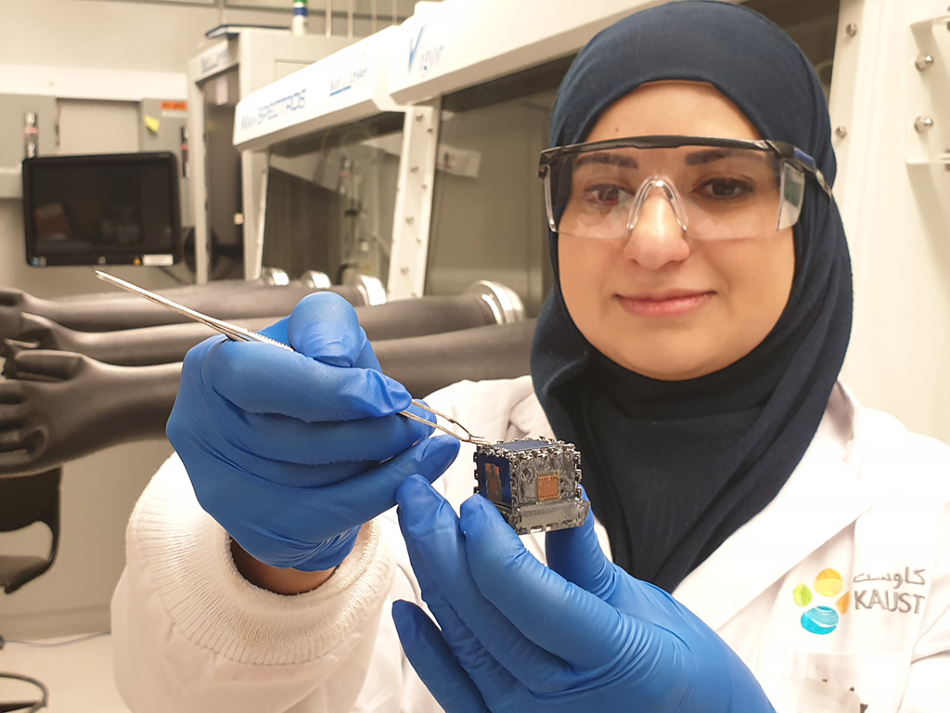Feb 28 2020
Water quality sensors driven by solar energy could support fish farmers in protecting their aquatic assets and secure the future of food.
 Nazek El-Atab with the team’s multisensory system. Image Credit: © 2020 KAUST.
Nazek El-Atab with the team’s multisensory system. Image Credit: © 2020 KAUST.
At present aquaculture supplies over half of the world’s seafood. In the past decade, the returns from global fish farming have increased by four times to over $230 billion per year. But pollution caused by industrial activities has been permeating into commercial ponds and destroying fish worth millions of dollars.
For instance, fertilizers used for agriculture boost nutrients in the water, resulting in algal blooms. The decomposing algae consume the oxygen supply totally, leading to the suffocation of fish.
Through water quality monitoring, fish farmers can immediately respond when hazardous pollution levels are detected. But a majority of the commercial sensors detect only one thing at a time, such as oxygen levels or acidity, on individual devices that must be manually checked by the farmer. The multifunctional alternatives are costly, huge, and require an expert operator.
It is difficult to develop electronic devices that perform various functions at the same time. In general, there exists a tradeoff between quantity and quality of functions. Muhammad Hussain, an electrical engineer at KAUST, and his colleagues developed a small self-driven sensor that detects several water quality characteristics and transfers the data through Bluetooth.
The scientists used a multidimensional integrated circuit (MD-IC) to create this multisensory system.
Integrating different functions on to one computer chip is complex and expensive. But we have combined several chips into a cube so that each face serves a different purpose.
Nazek El-Atab, Study Lead Author, KAUST
Then, the linked chips function as a single device. The cube has been designed to float together with the sensors for temperature, pH, ammonia levels, and salinity on the downward-facing side. The weight of the casing is quantified to make sure it stays that way, even when fish disturb it.
We wanted to create something small and light weight. The farmer can simply throw the device into the water, and it rotates itself into the right position.
Nazek El-Atab, Study Lead Author, KAUST
The other outer faces are fitted with solar cells to charge the battery enclosed inside the cube, sensors for detecting air pollution, and an antenna for transfer of data to a mobile phone over Bluetooth.
The concept of MD-ICs is unique, as it opens up opportunities for single devices with internet of things applications. And water is always an intriguing medium for electronics.
Muhammad Hussain, Electrical Engineer, KAUST
Eliminating unnecessary fish deaths is a key step toward food security. “Saudi Arabia is investing 3.5 billion US dollars in aquaculture so it can produce 600,000 tons of seafood each year by 2030,” added Nazek.
The researchers believe their sensors will help achieve this aim. They are also confident that the little cubes could have huge implications apart from the fish farm. “They could be sent down oil pipes to collect data on oil quality,” Nazek said. The team has been striving to enhance the self-cooling technology of the device to prevent its overheating. The step forward would be subject the device to field-test.
The contribution of the visiting undergraduate summer interns from Princess Noura University, the largest women’s university in Saudi Arabia, was also crucial for the study. “This exemplifies the commitment of KAUST to collaborate with in-Kingdom universities,” added Hussein.